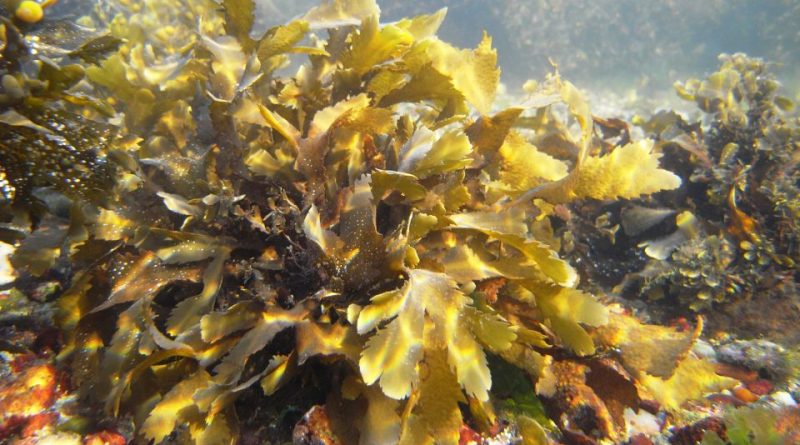Fucus serratus
Fucus serratus
Serrated wrack (Fucus serratus Linnaeus 1753) is a brown marine alga belonging to the Fucaceae family.
Systematics –
From a systematic point of view it belongs to:
Eukaryota Domain,
Kingdom Chromista,
Division Heterokontophyta,
Phaeophyceae class,
Fucales Order,
Fucaceae family,
Genus Fucus,
F. serratus species.
Over time, this seaweed has been named with many synonyms, including:
– Fucus serratus var. latifolius Turner 1809;
– Fucus serratus var. integer Turner 1809;
– Fucus serratus var. angustifolius Stackhouse 1816;
– Fucus serratus var. integerrimus C. Agardh 1820;
– Fucus serratus var. arcticus J.Agardh 1868;
– Fucus serratus f. arcticus (J.Agardh) Kjellman 1880;
– Fucus serratus f. abbreviatus Kjellman 1883;
– Fucus serratus f. angustus Kjellman 1883;
– Fucus serratus f. grandifrons Kjellman 1883;
– Fucus serratus var. lacinatus Greville 1890;
– Fucus serratus f. elongatus Kjellman 1890;
– Fucus serratus f. laciniatus Kjellman 1890;
– Fucus serratus f. typicus Kjellman 1890;
– Halidrys serrata (Linnaeus) Stackhouse 1809;
– Virsodes serratum (Linnaeus) Kuntze 1891.
Etymology –
The term Fucus comes from the Greek phukos “sea alga”, of Semitic origin.
The specific epithet serratus, means serrated, from greenhouse saw: usually referring to the margin of the leaves.
Geographic Distribution and Habitat –
Fucus serratus is a brown alga present in a vast area of the North Atlantic, and native to the British and Atlantic islands of Northern Europe and America.
This seaweed widespread in cold and temperate climates.
Description –
This brown alga has an olive-brown color and is somewhat similar to the Fucus vesiculosus and Fucus spiralis species.
It has a stem about two meters high and double-branched laminae called thalli which have swellings full of gelatinous substances, called conceptacles. These represent the reproductive system of the seaweed that reproduces quietly in cold climates, while it becomes sterile in hot ones.
It presents the terminal parts of the thallus in a serrated form.
Cultivation –
Serrated wrack is an alga that can also be cultivated. The cultivation, unlike the common agricultural species, takes place in the seabed and not in the fields. The seabed for the cultivation of fucus seaweed must be sandy and shallow in order to prevent its propagation, which is driven by throwing large stones into the sea. These create spaces devoid of vegetation, useful for facilitating the collection and cutting of the fucus. The seaweed is mowed every two years. This alga survives out of water for only 5 hours.
Customs and Traditions –
Fucus serratus is an algae widely used in herbal medicine for its recognized medicinal properties that make it useful in cases of obesity, diabetes, intestinal disorders and poor thyroid function. Its beneficial effects are due to the presence of substances such as mucopolysaccharides, including alginic acid, iodine, bromine, beta-carotene, mineral salts and vitamin C.
The main property of the seaweed is related to the stimulation of the basal metabolism, due to the presence of iodine, both in protein and inorganic form. Iodine stimulates the energy consumption of the mitochondria of the cells, leading to an acceleration of the metabolism and the consequent reduction of problems resulting from poor thyroid function, such as obesity or common excess weight. For these characteristics, Fucus serratus is also used as an adjuvant in diets aimed at slimming. In fact, it allows you to eat less, thanks to the induction of a sense of satiety. Alginic acid is also beneficial for disorders, such as gastritis and gastroesophageal reflux, which lead to damage to the mucous membrane of the stomach. The derivatives of algin, in fact, contain protective gels for the mucosa of the same which is shielded from the harmful action of gastric juices altered by the disease.
Fucus serratus has also been shown to lower glycemic indices, which are useful for diabetics. It can also work as an excellent iodine supplement, especially for individuals who are particularly deficient in this substance and who, precisely because of this deficiency, are prone to develop serious thyroid diseases such as hypothyroidism or goiter. It also has laxative effects that can be used in case of constipation.
Fucus serratus is an alga used in Ireland and France for the production of cosmetics and for thalassotherapy. In the Western Isles of Scotland it is harvested for use as a liquid fertilizer.
It also has a high nutritional value and helps strengthen hair and revitalize and protect the skin. Contains large amounts of vitamins, minerals and trace elements, and forms a barrier on the skin, keeping it well hydrated.
Fucus serratus secretes a mixture of oxidized polyphenols, carbohydrate polymer alginate and calcium chloride.
Preparation Method –
Fucus serratus is normally found on the market in the form of capsules or herbal teas.
Guido Bissanti
Sources
– Acta Plantarum – Flora of the Italian Regions.
– Wikipedia, the free encyclopedia.
– Useful Tropical Plants Database.
– Conti F., Abbate G., Alessandrini A., Blasi C. (ed.), 2005. An annotated checklist of the Italian vascular flora, Palombi Editore.
– Pignatti S., 1982. Flora of Italy, Edagricole, Bologna.
– Treben M., 2000. Health from the Lord’s Pharmacy, Advice and experiences with medicinal herbs, Ennsthaler Editore.
Warning: Pharmaceutical applications and alimurgical uses are indicated for informational purposes only, they do not represent in any way a medical prescription; therefore no responsibility is taken for their use for curative, aesthetic or food purposes.


